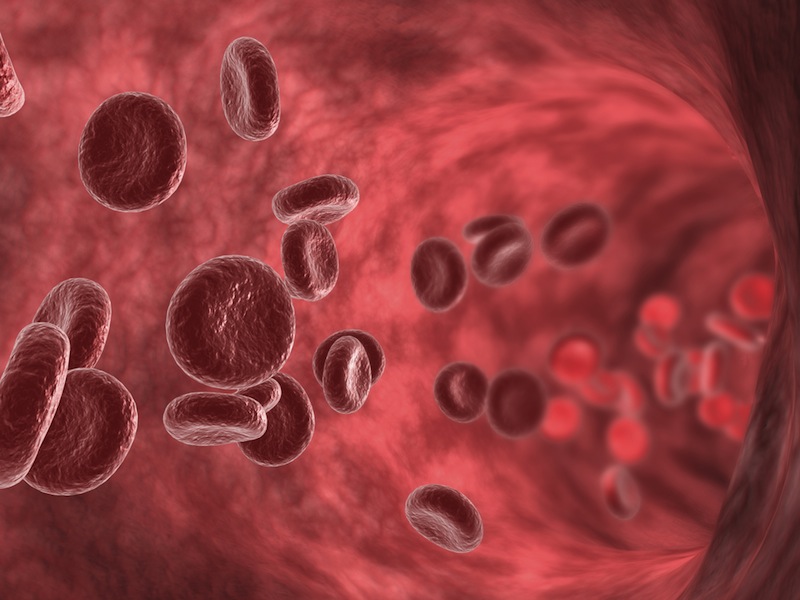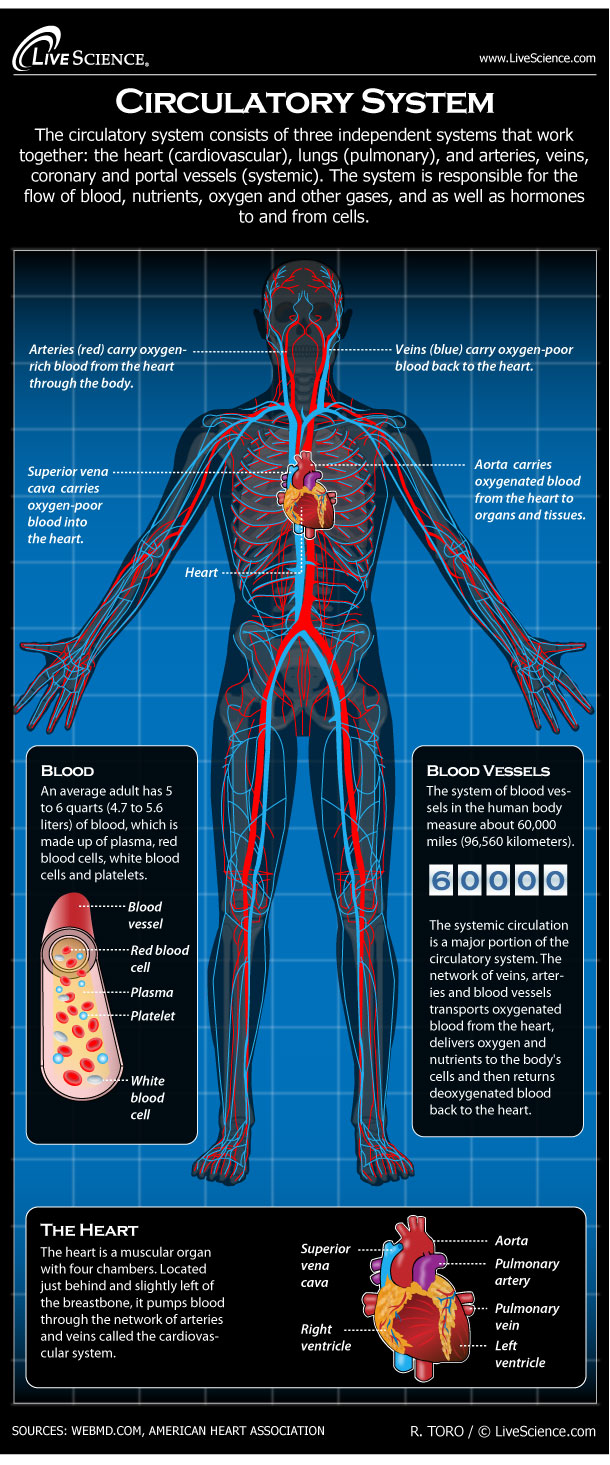The Circulatory System: An Amazing Circuit That Keeps Our Bodies Going
Reference Article: Facts about the human circulatory system.

The circulatory system, also known as the cardiovascular system, is a vast network of organs and blood vessels that acts both as a delivery and waste removal system for the body. Nutrients, oxygen and hormones are delivered to every cell and as these necessities are provided, waste products such as carbon dioxide are removed, according to the nonprofit Nemours Children's Health System.
Not only does the circulatory system keep our cells healthy, but it also keeps us alive. The heart constantly receives signals from the rest of the body that direct how hard it needs to pump to properly supply the body with what it needs, according to Nemours. For example, when asleep, the body sends electrical signals to the heart that tell it to slow down. When participating in heavy exercise, the heart receives the message to pump harder to deliver extra oxygen to the muscles.
How the circulatory system works
The heart lies at the center of the circulatory system and pumps blood through the rest of the network. This hollow muscle is made up of four chambers: The left and right atriums make up the two chambers at the top and the left and right ventricles form the two chambers at the bottom, according to the University of Michigan. The chambers are separated by one-way valves to ensure that blood flows in the correct direction.
The rest of the circulatory system is made up of two independent networks that work together: The pulmonary and systemic systems.
The pulmonary system is responsible for providing fresh oxygen to the blood and removing carbon dioxide, according to the National Center for Biotechnology Information (NCBI). Oxygen-poor blood arrives from veins leading to the right atrium of the heart. The blood is then pumped through the right ventricle, then through the pulmonary artery, which splits off into two and divides into increasingly smaller arteries and capillaries before entering the lungs. The tiny capillaries form a network within the lungs that facilitate the exchange of carbon dioxide and oxygen. From the lungs, the oxygen-rich blood flows back toward the heart.
Next, the systemic system of arteries, veins and capillaries takes over. Arteries and veins are not the same, although they are both types of blood vessels. Arteries carry oxygen- and nutrient-rich blood from the heart to all parts of your body, according to the National Cancer Institute. Veins carry the oxygen- and nutrient-poor blood back to the heart. The capillaries are the smallest type of blood vessel, and provide the bridge between the arteries and veins.

As the oxygen-rich blood arrives from the lungs, it enters the left atrium and then travels through to the left ventricle before being pumped throughout the body, according to NCBI. The blood gets pumped through the aorta artery (the largest artery in the body) before entering the smaller arteries that carry the blood to every part of the body. As the blood delivers nutrients and oxygen to each cell, carbon dioxide and other waste products are picked up as the blood flows through the capillaries and into the veins.
The contraction and relaxation of the heart – the heartbeat – is controlled by the sinus node, which is a cluster of cells situated at the top of the right atrium. The sinus node sends electrical signals through the electrical conduction system of the heart that direct the muscle to contract or relax.
The heartbeat is divided into two phases: the systole and diastole phases. In the first, the ventricles contract and push blood out into the pulmonary artery or the aorta. At the same time, the valves separating the atria and ventricles snap shut to prevent blood from flowing backwards. In the diastole phase, the valves connecting to the atrium open, and the ventricles relax and fill with blood. The sinus node controls the pace of these two phases.
Adult humans have a total of about five to six quarts (a little less than five to six liters) of blood pumping through their bodies, according to Arkansas Heart Hospital. On average, the heart pumps about 100,000 times per day, pushing about 2,000 gallons (7,570 liters) of blood through a total of 60,000 miles (96,560 kilometers) of blood vessels. It only takes about 20 seconds for blood to travel through the entire circulatory system.
Circulatory system diseases
Heart disease is the leading cause of death for both men and women in the United States, claiming 610,000 people per year, according to the Centers for Disease Control and Prevention.
Heart disease is a broad term that covers a wide range of diseases and disorders, including stroke (the blockage of blood to the brain), heart attack (the flow of blood to the heart is blocked), hypertension (high blood pressure causing the heart to work harder), arteriosclerosis (the arteries become thick and stiff) and aneurysm (a damaged blood vessel that can lead to internal bleeding).
Wondering how to improve your circulation? Risk factors for heart disease include age, sex, family history, poor diet, smoking and stress, as well as high blood pressure and elevated cholesterol levels, according to the Mayo Clinic. There are many ways that heart disease can be prevented, including keeping other health conditions under control, maintaining a healthy diet, participating in regular physical activity and keeping stress levels at a minimum.
Additional resources:
- Watch: What’s inside of blood? from the Khan Academy.
- Learn how heart attack symptoms differ between men and women, from the American Heart Association.
- Watch: 5 surprising hazards to your heart, from the American Heart Association.
This article was updated on Aug. 8, 2019, by Live Science Contributor Rachel Ross.
Sign up for the Live Science daily newsletter now
Get the world’s most fascinating discoveries delivered straight to your inbox.
Kim Ann Zimmermann is a contributor to Live Science and sister site Space.com, writing mainly evergreen reference articles that provide background on myriad scientific topics, from astronauts to climate, and from culture to medicine. Her work can also be found in Business News Daily and KM World. She holds a bachelor’s degree in communications from Glassboro State College (now known as Rowan University) in New Jersey.










